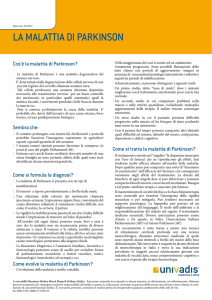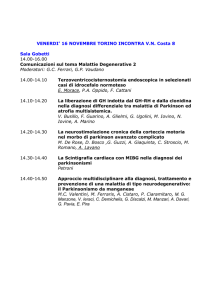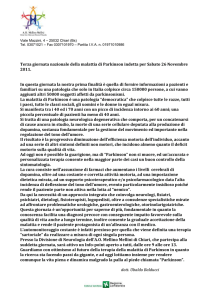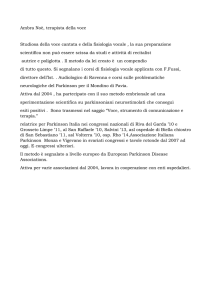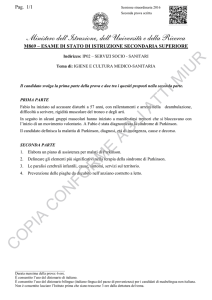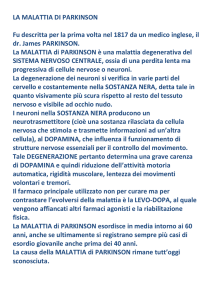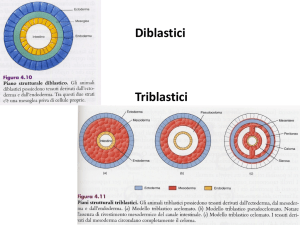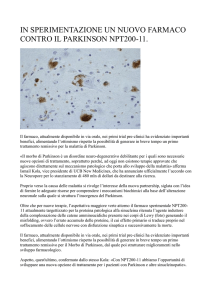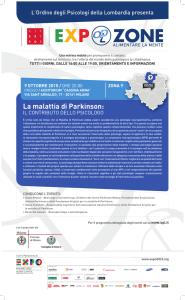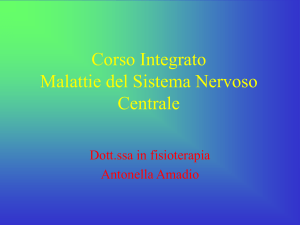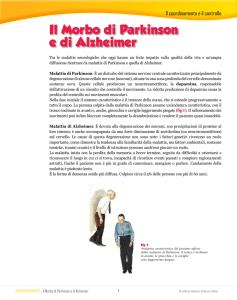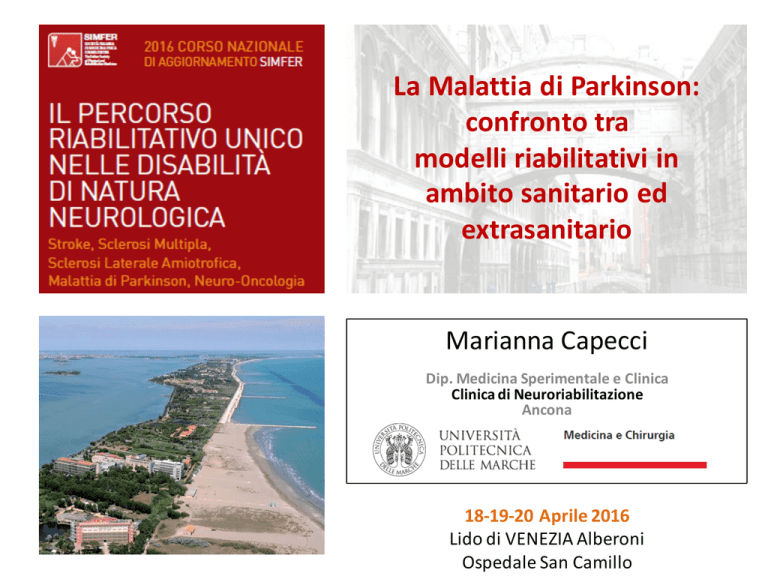
La Malattia di Parkinson:
confronto tra
modelli riabilitativi in
ambito sanitario ed
extrasanitario
Marianna Capecci
Dip. Medicina Sperimentale e Clinica
Clinica di Neuroriabilitazione
Ancona
18-19-20 Aprile 2016
Lido di VENEZIA Alberoni
Ospedale San Camillo
1
Definizione… operativa
Processo educativo, mirato a
risolvere un problema che si
focalizza sulle limitazioni
nell’attività ed è mirato
all’ottimizzazione della
partecipazione sociale ed al
benessere (well-being) del
paziente e, di conseguenza, a
ridurre lo stress in coloro che
erogano l’assistenza (carer/family)
•
•
•
“La riabilitazione è l’archetipo dell’intervento complesso in medicina”
È efficace nel ridurre morbilità e mortalità
… ma, siamo incapaci di descrivere, nel dettaglio, quali approcci siano specificamente efficaci
e su cosa.
Wade, ‘05
2
POSITION PAPER
LA RIABILITAZIONE DELLE
PERSONE IN CONDIZIONI DI
CRONICITA’ E DISABILITA’
VERSIONE ESTESA
SOCIETA’ ITALIANA DI
MEDICINA FISICA E
RIABILITATIVA
(S.I.M.F.E.R.)
Gruppo tecnico per
l’elaborazione del
documento:
M. Massucci: Coordinatore
•
La “CONDIZIONE DI CRONICITA’” è uno stato di alterazione della salute
che si protrae nel tempo, usualmente oltre i 12 mesi, dovuta ad una o più
situazioni morbose, che di norma comporta limitazioni del
funzionamento (disabilità) e necessità di monitoraggio e/o di interventi
sanitari prolungati, di tipo continuativo od intermittente.
•
La/le situazioni morbose che conducono ad una condizione di cronicità
possono agire in modo sinergico o indipendente nel tempo, essere
reversibili o non reversibili, trasmissibili o non trasmissibili, a decorso
ingravescente o stazionario o regressivo, e possono presentarsi in tutte le
età.
•
La PERSONA IN CONDIZIONE DI CRONICITA’/DISABILITA’” (CCD) è
caratterizzata da una condizione di cronicità che determina persistenti
limitazioni del funzionamento (disabilità).
•
Tali limitazioni possono essere stabili, ingravescenti o ad andamento
remittente, e necessitano di monitoraggio e/o di interventi riabilitativi
protratti nel tempo o permanenti.
firmato Settembre – pubblicato
Dicembre 2015
COMPLESSITA’
2
COMPLESSITA’
Nell’accezione più
completa di complessità le
componenti di tipo
- biologico,
- socioeconomico
- culturale,
- comportamentale ed
- ambientale,
diventano tutte
determinanti di salute
Schaink AK et al. J Comorbildity 2012
2
POSITION PAPER
LA RIABILITAZIONE DELLE PERSONE IN CONDIZIONI DI
CRONICITA’ E DISABILITA’ Position Paper SIMFER 2015
Da Department of Health. Improving Chronic Disease Management.
2004, modif. .
Barr et al. Healthcare Quarterly, 7(1) November 2003: 73-82.doi:10.12927/hcq.2003.16763
The expanded chronic care model
The Ottawa Charter for
Health Promotion refers to
five action areas:
• develop personal skills
• re-orient health services
• build healthy public policy
• create supportive
environments
• strengthen community
action.
1) SELF-MANAGEMENT SUPPORT, :ENGAGEMENT AND
EMPOWERMENT OF CHRONICALLY DISABLED PEOPLE
2) DECISION SUPPORT,
3) DELIVERY SYSTEM DESIGN AND
4) INFORMATION SYSTEMS.
These four circles now straddle the border between the health
system and the larger community
2
PUNTI CHIAVE
CRONICITA’
POSITION PAPER S.I.M.F.E.R.
•
•
•
•
•
LA RIABILITAZIONE DELLE PERSONE IN
CONDIZIONI DI CRONICITA’ E
DISABILITA’
•
Gruppo tecnico per l’elaborazione del
documento:
M. Massucci: Coordinatore
PREVALENZA CRESCENTE
Impatto ECONOMICO, SOCIO/SANITARIO PESONALE/umano
--> Limitazioni del funzionamento (DISABILITA’)
Bisogni assistenziali specifici: necessità di interventi riabilitativi,
volti a favorire il recupero od il mantenimento dell’autonomia e del
massimo livello di partecipazione sociale.
La cronicità deve essere vista in termini di condizione di salute che si
può presentare in tutte le età indipendentemente da singole
condizioni morbose,
Diverso approccio alle problematiche di salute:
– centrata sulla persona
– Secondo l’approccio biopsicosociale.
– integrazione dei saperi, delle competenze e delle
professionalità,
– Sulla valutazione e misura dei bisogni, sulla
progettazione individuale e sulla verifica
– di una visione sistemica ed inclusiva anche delle
componenti non professionali,
– approccio attraverso reti integrate di servizi.
ADULTS’ CHRONIC DISABILITIES
( chronic non-specific lung disease)
diabetes mellitus
(cardiovascular disease)
Prevalence of disability by cause
Klijs B et al Plos One ‘11
3
MALATTIA DI
PARKINSON
Archetipo della
patologia cronica
complessa associata a
disabilita’
•
•
•
•
Elevate Incidenza e prevalenza
Patogenesi degenerativa
Andamento lento
Espressione
Multisintom./dimensionale:
sintomi
–
–
–
–
motori
autonomici
cognitivi
Emotivo/comportamentale
• Terapia multidisciplinare:
– farmacologica
– chirurgica
– riabilitativa
Malattia di Parkinson: epidemiologia
•
Prevalenza:
Tassi di prevalenza
età e sesso specifici
– In Italia da 65 (Rosati ’80) a 257/100000 ab
(Morgante et al ’92)
•
Incidenza:
maschi
femmine
– Da 4.9 (Rosati ’80) a 23.8/100000ab/anno
4000
(Rajput et al ’84)
•
MP giovanile (esordio in età <40anni):
tra 1%(Kurland ’58) 18.5% (Narabayashi ’87)Schrag et al ’07 : 3-5% nei paesi
occidentali (10% in giappone)
3500
3000
casi/100000 ab
– A Ferrara dal 1967 al 1987 incidenza
stabile pari a 10/10000 ab/anno.!!
– Età media di insorgenza 62 anni (picco
tra i70 e 79 anni)
2500
2000
1500
1000
500
•
Variabilità nei dati!
• Differente struttura della popolazione
• Criteri diagnostici
• Criteri d’arruolamento
0
20
30
40
50
60
70
80
90 100
età
(Morgante et al ’92)
Malattia di Parkinson: epidemiologia
• Proiezioni:
– crescita della prevalenza in Europa ed Asia !!!
• Causa: aumento incidenza e sopravvivenza
(Dorsey et al ’07)
Malattia di Parkinson: patofisiologia
• Malattia degenerativa
del sistema nervoso
centrale
• Degenerazione dei
neuroni dopaminergici
della pars compacta
della substantia nigra
Malattia di Parkinson e stadi di Braak
Neurophysiology - Cersosimo & Benarroch J Neuro Sci‘12
Malattia di Parkinson: eziologia
FATTORI
AMBIANTALI
GENETICI
DANNOSI
a-synuclein
Pesticidi
parkin
Manganese
PINK
1
idrocarburi
MPTP
DJ-1
LRRK2
PROTETTIVI
Fumo di sigaretta
caffè
Malattia di Parkinson: clinica - SINTOMI
SINTOMI
MOTORI
ESORDIO
SEDE/ note
FREQUENZA
TREMORE a riposo*
PRECOCE
ARTI, MENTO
ASIMMETRICO
70%
RIGIDITA’ *
PRECOCE
ARTI, ASIMMETRICO,
100%
BRADICINESIA *
PRECOCE
ARTI ASIMMETRICO,
ASSIALE PIU’
TARDIVAMENTE
100%
IPOFONIA MONOTONIA
DELLA VOCE
PRECOCE
-
98%
MICROGRAFIA
PRECOCE
-
90%
IPOMIMIA/AMIMIA
PRECOCE
-
100%
INSTABILITA’
POSTURALE *
TARDIVO
SINTOMO ASSIALE
100%
FESTINAZIONE DELLA
MARCIA
TARDIVO
Generalm. L_DOPA
responsivo
30-40%
FREEZING DELLA MARCIA
TARDIVO
L-DOPA RESP.
L-DOPA RESIST.
46%
- una volta/anno
- settimanalmente
-70%
- 13%
CADUTE
TARDIVO
Dovute o no a
freezing?
* SINTOMI CARDINALI
Jankovic ‘15
Malattia di Parkinson: clinica - SINTOMI
SINTOMI
DISTURBI AUTONOMICI
ESORDIO
SEDE/ note
FREQUENZA
DISFAGIA
TARDIVO
DISF. URO/GENITALE
TARDIVO
liquidi inizialm.
Instabil. Detrusoriale
impotenza
55%**
IPOTENSIONE
ORTOSTATICA
GASTRL./DISPEPSIA
TARDIVO
STIPSI
Qualsiasi stadio
Qualsiasi stadio
DROOLING
TARDIVO
IPERIDROSI
Qualsiasi stadio
DOLORE
Precoce / tardivo (associato
agli OFF)
Ipersonnia /sleep attacks
Qualsiasi stadio
DISTURBO DEL SONNO
REM
Qualsiasi stadio
anche preclinico
Qualsiasi stadio
anche preclinico
Qualsiasi stadio
IPOSMIA
FATICA
15%
-
53%**
68%**
CORRELATO ALLA
DISFAGIA
59% (27% severo)
-
10%
Articolare, addominale,
Poli distrettuale
migrante, distonico
15%
20-25% - 1/27%
47%
33%
81%
**
Malattia di Parkinson: clinica - SINTOMI
SINTOMI
ESORDIO
SEDE/ note
FREQUENZA
Qualsiasi stadio
si può associare a demenza
12-16%
DEPRESSIONE
Qualsiasi stadio
anche preclinico
Overlaps di sintomicon MP
Presente in stadio 1 più che in
stadio IV
Predittivo di maggiore disabilità
(percepita?)
7-72%
ANSIA
Qualsiasi stadio
DISTURBI DISESECUTIVI
Qualsiasi stadio
DIP. Età e COMORBILITA’
60-80%
Tardivo
Non all’esordio/infl. dall’età
10-40%
17-80%
IN MEDIA 40%
APATIA
DISTURBI COGNITIVOCOMPORTAMENTALI
DETER. COGNITIVO
DISTURBI DEL
COMPORTAMENTO
Tardivo
SDR DISPERCETTIVA
Tardivo
SINTOMI
>40%
CORRELATA A
DOPAMINOAGONISTI
E DETERIORAMENTO COGNITIVO
CORRELATA A
DOPAMINOAGONISTI
E DETERIORAMENTO COGNITIVO
ESORDIO
SINTOMMI
CORRELATI
ALTRATTAME
NTO A LUNGO
TERMINE CON
F.
DOPAMINERGI
CI
FLUTTUAZIONI
DISCINEISE
DISTONIE OFF
WEARING OFF
Tardivo
(5-12 ANNI)
10-40%
SEDE/ note
FREQUENZA
n.a.
80%
Tronco –arti
45%
Arti – collo – tronco
25%
n.a.
40%
Malattia di Parkinson:
stadiazione clinica sec. Hoehn & Yahr (‘67)
STADIO 0: NESSUN SEGNO DI MALATTIA
STADIO 1: COINVOLGIMENTO UNILATERALE
STADIO 1,5: COINVOLGIMENTO UNILATERALE E ASSIALE (RIGIDITA’ DEL COLLO)
STADIO 2: COINVOLGIMENTO BILATERALE SENZA ALTERAZIONE DELL’EQUILIBRIO
STADIO 2,5: COINVOLGIMENTO BILATERALE LIEVE CON INSTABILITA’ POSTURALE MA CAPACITA’
DI RIPRENDERE L’EQUILIBRIO QUANTO SPINTO
STADIO 3: COINVOLGIMENTO BILATERALE DA LIEVE A MODERATO ; INSTABILITA’POSTURALE
(INCAPACE DI RIPRENDERE L’EQUILIBRIO SE SPINTO) ANCORA FISICAMENTE
INDIPENDENTE
STADIO 4: DISABILITA’ GRAVE; IL PAZIENTE PUO’ ANCORA CAMMINARE O STARE IN PIEDI DA
SOLO MA E’ GRAVEMENTE DISABILE
STADIO 5: IL PAZIENTE E’ ALLETTATO O IN SEDIA A ROTELLE SE NON AIUTATO
Motor symptoms
EFFECTIVE MANAGEMENT OF
CLASSICAL MOTOR TROUBLES
REDUCED IMPACT ON SURVIVAL
AND NON MOTOR SYMPTOMS
SEVERELY AFFECTS
INDEPENDENCE AND
QUALITY OF LIFE
Limitations of Current Parkinson’s Disease Therapy
Rascol et al , Ann Neurol 2003
Progression rate
THE ONSET OF REFRACTORY
MOTOR SYMPTOMS
Disability
years
DISABILITY IS EVER GROWING OVER TIME
IN SPITE OF EFFECTIVE MOTOR SYMPTOM
CONTROL
(Schrag et al ’07)
Malattia di Parkinson: epidemiologia
•
Sopravvivenza:
•
Aspettativa di vita:
–
–
•
38 (SD 5) aa per MP
con esordio tra i 2539 aa (vn 49/SD5)
5(SD4) aa per MP
con esordio >65 (n.v.
9 (5SD)
Media dell’età
attesa per il decesso
Ishihara et al ‘07
Malattia di Parkinson: epidemiologia
•
Mortalità – FATTORI PREDITTIVI
–
–
–
–
–
–
–
–
–
ETA’ AVANZATA (relative rate (RR) 2.22; 95% (CI) 1.99–2.47, PER PTS 85+AA years),
SESSO MASCHILE (RR 1.73; 95% CI1.60–1.87),
GRAVE COMPROMISSIONE FUNZIONALE (RR 1.81; 95% CI 1.53–2.13)
GRAVE COMPROMISSIONE COGNITIVA (RR 1.54; 95% CI 1.38–1.72)
PROBLEMI DEL VISUS (RR 1.25; 95% CI 1.20–1.57),
DECUBITI (RR 1.25; 95% 1.14–1.37),
SCOMPENSO CARDIACO (RR 1.49;95% CI 1.35–1.65),
DIABETE MELLITO (RR 1.22; 95% 1.11–1.35)
POLMONITE (RR 1.39; 95% CI 1.09–1.77)
– LA SPECIFICA PRESENZA DI POLMONITE AB INGESTIS RAPPRESENTA IL FATTORE
PROGNOSTICO INDIPENDENTE PIU’ FORTE rispetto alle altre comorbilità (RR 1.58; CI
0.97–2.56).
Fernandez et al 2002
Malattia di Parkinson: TERAPIA
FARMACOLOGICA
CHIRURGICA
RIABILITATIVA
TEAM MULTIDISCIPLINARE
Summary of the recommendations of the EFNS/MDS-ES review on therapeutic
management of Parkinson’s disease (Ferreira et al EJN ‘13)
MdP: APPROCCIO SPECIFICO
Diagnosi
Terapia farmacologica.
Terapia farmacologica.
•Inibitori delle MAO-B
•Dopaminoagonisti
•L-DOPA
•Amantadina
•Anticolinergici
•Inibitori delle MAO-B
•Inibitori delle COMT
•Dopaminoagonisti
•L-DOPA
•Amantadina
•Anticolinergici
Fase precoce
Fase Intermedia
Hoehn & Yahr 1-2.5
Hoehn & Yahr 2.5-4
Neurochirurgia funzionale
•Pallidotomia
•DBS: VIM,
•GPi
•STN
•PPN
•DUODOPA
•Inf. Cont. APOMORFINA
Fase terminale
Hoehn & Yahr 5
APPROCCIO RIABILITATIVO.
APPROCCIO RIABILITATIVO.
APPROCCIO RIABILITATIVO.
Obiettivi:
• Prevenire l’inattività
• Promuovere la capacità fisica
• Ridurre la paura di cadere (e le
cadute)
Obiettivi:
• Prevenire le cadute
• Ridurre le limitazioni in:
Trasferimenti
Postura
Destrezza
Equilibrio
Cammino
Disfagia
Interventi:
Esercizi attivi, anche a domicilio, e attività
funzionali mediante:
• Strategie generiche
• Strategie specifiche per la MP:
Strategie cognitive per il
movimento
Strategie di Cueing esterno
• Informazione per la riduzione dei
comportamenti e compiti multitasking
Obiettivi:
• Mantenere le funzioni vitali
• Prevenire le lesioni da
decubito
• Prevenire contratture ed
anchilosi
Interventi:
• Adattamenti posturali a
letto o carrozzina
• Mobilizzazione attiva
assistita
• Informazioni aggiuntive
per la prevenzione di
lesioni da decubito e
contratture/anchilosi.
Interventi:
• Promozione di uno stile di vita
attivo
• Somministrazione di
informazioni per prevenire
l’inattività ed aumentare le
capacità fisiche
• Esercizi attivi (gruppo) per
migliorare l’equilibrio, la
potenza muscolare, la mobilità
articolare e la capacità aerobica
• Coinvolgimento del partner o del
carer
Mod da KEUS ‘07 e ’09
Position Paper Simfer 2015
Cosa distingue significativamente il
soggetto con PD in fase iniziale e il
soggetto non PD ??
•
Movement amplitude generation
(Morris M et al ’94)
•
APA (Rocchi ‘06, Burleigh et al., 1994; Elble et
al., 1994).
•
•
•
•
•
Asimmetria, variabilità
Sdr Disesecutiva (Jankovic ‘16)
Disturbi del sonno (Jankovic ‘16)
Stipsi, (Jankovic ‘16)
Ansia, depressione (Jankovic ’16)
•
Effetto cueing (Lewis et al’07)
Studiati durante l’avvio (Rocchi ‘06) del cammino e il turninig
(Carpinella et al ’06; Crenna et al ’07, Cole et al ‘10)
GROUP
N
from
PD
699
ParkinsonNet trial
CONTROLS
1959
Longitudinal Aging Study Amsterdam (LASA)
Daily physical activity = LAPAQ
PD =t 111 min/day (interquartile range 58–206) on
daily physical activity,
Controls= 150 min for controls (interquartile range
89–232).
On average 29% reduction in PD versus controls
(95% CI, 10–44%; p\0.01
While disease severity, gait, and disability in daily living predicted part of the
inactivity, a portion of the variance remained unexplained, suggesting that
additional determinants may also affect daily physical activities in PD.
Because physical inactivity has many adverse consequences, work is needed to
develop safe and enjoyable exercise programs for patients with PD.
• The National Parkinson's
Foundation (NPF) QII Registry data
was used to analyze variables that
correlate with levels of exercise in
PD patients across disease severity
• Subjects were categorized into
three groups:
– non-exercisers (0 min/week),
– low exercisers (1e150 min/week), and
– regular exercisers (>150 min/week).
4866 subjects were included in the baseline analysis and 2252 subjects who had second visits were
included in the longitudinal data.
Oguh et al
Parkinsonism Rel Disord ‘14
VALUTAZIONE TRASVERSALE
BASALE (N4866)
Exercise “dose” matters as
demonstrated by the association of
exercise frequency with less PD
severity and better cognitive status”
subjects with a history of falls were
less likely to engage in regular
exercise. This might reflect the fact
that an increased fear of falls leads
to inactivity and hence less exercise
Correlazione dell’esercizio con:
- QoL
- Mobility
- TUG
- MCSI (Multidim. Cargiving Strain
Index)
Predittività
Oguh et al Parkinsonism Rel Disord ‘14
•
•
VALUTAZIONE longitudinale (N2252)
“Regular exercisers at baseline were associated with better QOL, mobility, and
physical function less progression of disease, less caregiver burden and less
cognitive decline one year later, after controlling for demographic and disease
severity variables”
It is not just any kind of EXPERIENCE
that facilitates neuroplasticity
The MEANINGFULNESS of the task
L’ESERCIZIO: Termine generico con il quale si vuole indicare
l’attività fisica pianificata, strutturata e ripetitiva, al fine di
coinvolgere ogni parte del corpo.
ESERCIZIO GOAL-BASED
Allenamento compitospecifico che possiede
parametri di:
•
•
•
•
•
Intensità
Ripetitività
Specificità
Difficoltà
Complessità
ESERCIZIO AEROBICO
• Attività vigorosa e sostenuta
che determina un
innalzamento
• delle funzioni cardiopolmonari, con conseguente
aumento del consumo di O2 e
flusso sanguigno al cervello.
• Tipicamente, l’intensità
dell’esercizio aerobico deve
mantenersi tra il 60-85% della
frequenza cardiaca massima.
Petzinger et al. Lancet Neurol 2013
98% 81%
INTENSIVE TREADMILL TRAINING ELEVATES D2 RECEPTOR IN THE STRIATUM
Goal-Based + Aerobic Exercise
Treadmill
Il Treadmill è solitamente utilizzato per migliorare le capacità del cammino.
Studi su treadmill hanno dimostrato che individui con Parkinson da lieve a moderato
possono migliorare le performance del cammino, inclusa la velocità, la lunghezza del passo,
la cadenza, il ritmo del cammino e l’escursione articolare.
(Tomlison et al., 2014)
UPDRS (parte II, III , IV)
(Frazzitta ’12)
Goal-Based /Aerobic Exercise
Exercise
Outcome improved
Ref
Danza
equilibrio, cammino e
capacità di dual tasking.
Duncan e Earhardt (2012)
Amplitude training
velocità e ampiezza di
movimento.
(Farley et al., 2005)
Tai Chi
lunghezza del passo,
massima escursione
articolare, cadute.
(Li et al., 2012)
Box
equilibrio e del cammino.
(Combs et al., 2010)
Strategie addizionali
?? equilibrio e capacità di
Giochi elettronici (WII),
dual tasking.
realtà virtuale, allenamento
dual task,
(de Bruin et al., 2010) (dos
Santos Mendes et al., 2012)
Petzinger ‘13
Types of interventions
Physiotherapy interventions aim to maximise functional
ability and minimise secondary complications through
movement rehabilitation within a context of education
and support for the whole person.
Physiotherapy encompasses a wide range of techniques,
so we were inclusive in our definition of physiotherapy
intervention (including those not directly delivered by a
physiotherapist)
Cochrane 2001
Cochrane 2014
Trials available for inclusion (N)
7
43
Participants randomised (N)
210
1673
Assessment period
2 weeks
24 months
Age (mean)
67 years
Male (%)
62
Hoehn & Yahr (mean)
2.4
Disease duration (mean)
7 years
The most frequently reported physiotherapy outcome measures were gait speed and
timed up and go. The motor subscales of the UPDRS and PDQ-39 were the most
commonly reported clinician-rated disability and patient-rated quality of life outcome
measures respectively
Approcci Riabilitativi
Approcci classici
•
•
Fisiochinesiterapia
streatching, l‘allenamento muscolare, la
•
rieducazione dei passaggi posturali, la
rieducazione dell‘instabilità posturale e del
cammino e l‘addestramento a strategie cognitive
Musicoterapia
•
Danzaterapia
•
Teatroterapia
•
T’ai chi ch’üan
Terapia occupazionale
risolvere le difficoltà presenti nelle ADL
•
Cues e stategie attenzionali
•
Strategie attenzionali
incrementare l‘ampiezza del passo ed il loro
vantaggio rispetto alle cues è la maggiore
riproducibilità
•
Approcci Riab. Alternativi
Il treadmill
Un ciclo di sedute di treadmill determina un
visibile miglioramento della performance motoria
nella MP rispetto al trattamento fisioterapico: si
può notare un aumento della lunghezza del passo,
aumento della velocità del cammino e riduzione
dei sintomi parkinsoniani
Tomlinson et al Cochrane 2013
Misure di outcome
GAIT OUTCOMES such as:
a.TWO- OR SIX-MINUTE WALK TEST (M) (Kersten 2004);
b.WALKING SPEED:
i.10- or 20-metre walk test (s), (Kersten 2004),
ii.velocity (m/s) (Trew 2005);
CLINICIAN-RATED IMPAIRMENT AND DISABILITY :
a.HOEHN AND YAHR, (Hoehn 1967);
b.UNIFIED PARKINSON’S DISEASE RATING SCALE
(UPDRS), (Fahn 1987):
c. WEBSTER RATING SCALE (Webster 1968);
d.COLUMBIA UNIVERSITY RATING SCALE (Yahr 1969).
iii. cadence (steps/min) (Trew 2005);
iv.stride length (m) (Whittle 1996);
v.step length (m) (Trew 2005);
PATIENT-RATED QUALITY OF LIFE:
FUNCTIONAL MOBILITY AND BALANCE OUTCOMES
a.PARKINSON’S DISEASE QUESTIONNAIRE-39 (PDQ-39),
(Jenkinson 1997; Peto 1995);
b.PDQUALIF, (Welsh 2003);
c.PDQL, (Deboer 1996);
such as:
d.Short Form-36 (SF-36) or 12 (SF-12 (Ware 1992).
c.FREEZING OF GAIT QUESTIONNAIRE, (Giladi 2000)
a.TIMED UP AND GO (S), (Podsiadlo 1991);
b.FUNCTIONAL REACH TEST (CM ), (Duncan 1990);
c.BERG BALANCE SCALE,(Berg 1992; Qutubuddin
2005);
d.ACTIVITY SPECIFICBALANCECONFIDENCE
Trials reported
data on Falls (N)
5 (11%)
(Powell 1995; Talley 2008).
Tomlinson et al Cochrane 2013
Tomlinson et al Cochrane 2014
RESULTS
Types of outcome measures
Results
GAIT OUTCOMES such as:
WALKING SPEED
• Physiotherapy and cardiovascular Exercise
with visual cues > conventional PKT (mean
difference between arms 0.34 m/s)(Dias
2005);
• Treadmill with auditory and visual Cues >
auditory and visual Cues (Frazzitta 2009;
mean difference between arms0.1 m/s);
• Body weight supported treadmill training >
Physical therapy ( Miyai 2002; mean
difference between arms 0.16 m/s);
• Rhythmic auditory stimulation group >
Standard Self paced training, no training
(Thaut 1996; mean difference between arms
0.093 m/s);
• Downhill walking group > PKT(Yang 2010 ;
mean difference between arms 0.15m/s))
a. TWO- OR SIX-MINUTE WALK TEST (M)
(Kersten 2004);
b. WALKING SPEED:
i.
10- or 20-metre walk test (s), (Kersten 2004),
ii.
velocity (m/s) (Trew 2005);
iii.
cadence (steps/min) (Trew 2005);
iv.
stride length (m) (Whittle 1996);
v.
step length (m) (Trew 2005);
c.
FREEZING OF GAIT QUESTIONNAIRE, (Giladi
2000)
gentilmente da Alice Nieuwboer
CUEING: evidence based medicine
FREEZING (FOG)
Tomlinson et al Cochrane 2013
Tomlinson et al Cochrane 2014
RESULTS
TYPES OF OUTCOME MEASURES
FUNCTIONAL MOBILITY AND
BALANCE OUTCOMES such as:
a.
TIMED UP AND GO (S), (Podsiadlo 1991);
b.
FUNCTIONAL REACH TEST (CM), (Duncan
1990);
c.
BERG BALANCE SCALE, (score ranges from 0 to 56;
with 0 to 20 = high fall risk; 21 to 40 = medium fall risk;
and 41 to 56 = low fall risk (Berg 1992; Qutubuddin 2005);
d.
ACTIVITY SPECIFICBALANCECONFIDENCE. a
16-itemself-report questionnaire that asks individuals to
rate their confidence that they will maintain their balance
in the course of daily activities. Each item is rated from 0%
(no confidence) to 100% (complete confidence) (Powell
1995; Talley 2008).
Results
TUG
• LSVT BIG training > Nordic
Walking, Home exercise
(Ebersbach 2010; TUG)
• tango > waltz or foxtrot and
Tai Chi (Hackney 2009; TUG)
DANCE AND MUSIC IN PD REHABILITATION
BBS
TUG
STRIDE
LENGHT
GAIT
VELOCITY
UPDRS III
PDQ-39
NEUROCOGNITIVE CONTROL IN DANCE PERCEPTION AND PERFORMANCE
Bläsing et al. Acta Psychologica 139 (2012) 300–308
SOCIAL
INTERACTIONS
MULTIPLE BODIES
MOVING IN A
SPECIFIED
RHYTHMICAL
MANNER WITH OR
WITHOUT MUSIC
ESTHETIC
ELEMENTS
• limb coordination,
• flexibility,
• and strength
TOPICS
1.
MOTOR CONTROL, in terms of
postural control, equilibrium
maintenance, and stabilization;
2.
TIMING AND ON-LINE
SYNCHRONIZATION influenced by
attention demands and motor
experience;
3.
the critical roles played by SEQUENCE
LEARNING AND MEMORY;
4.
strategic use of VISUAL AND MOTOR
IMAGERY;
5.
the insights into the NEURAL
COUPLING BETWEEN ACTION AND
PERCEPTION yielded through
exploration of the brain architecture
mediating dance OBSERVATION; and
6.
a NEUROESTHETICS PERSPECTIVE
that sheds new light on the way
audiences perceive and evaluate
dance expression.
DOMAINS
reward,
motivation
and pleasure
NEUROCHEMICAL SYSTEMS
DOPAMINE AND OPIOIDS
stress and
arousal
CORTISOL, CORTICOTROPHIN-RELEASING
HORMONE (CRH), ADRENOCORTICOTROPIC HORMONE (ACTH);
Immunity
SEROTONIN AND PROOPIOMELANOCORTIN (POMC), ALPHAMELANOCYTE STIMULATING HORMONE
AND BETA-ENDORPHIN
social
affiliation
OXYTOCIN
Barone et al. THE PRIAMO STUDY. ‘09
ECONOMIA DEL CAMMINO
Tomlinson et al Cochrane 2013
Qualità ed Economia
del cammino
L’intensità e la capacità
residua influenzano l’effetto
clinico
UPDRS TOTALE
Tomlinson et al Cochrane 2013
UPDRS ADL
Tomlinson et al Cochrane 2013
UPDRS MOTORIA
Tomlinson et al Cochrane 2013
Tomlinson et al Cochrane 2014
Results
Types of outcome measures
FALLS :
a.
b.
c.
NUMBER OF PATIENTS FALLING,
E.G. FALLS DIARy;
FALLS EFFICACY SCALE, (a total
score of 70 or more indicating that a
person has a fear of falling) (Tinetti
1990);
FALLS EFFICACY SCALE
INTERNATIONAL, a 16-item
questionnaire that includes the 10
original items of the standard Falls
Efficacy Scale as well as six items
regarding higher functioning and
social activities. Each item is rated on
a scale of 1 to 4, with 1 being ‘not
concernedat all’ and 4 being ‘very
concerned’ (maximum score out of
64) (Yardley 2005).
Results
N° and RATE of falls.
progressive strength training
arm > movement strategy
training arm (n = 10 versus n =
24; P = 0.006) (McGinley 2012)
mean latency to fall and the
proportion of falls
• Combined balance and
resistance training >
Balance Training group
(Hirsch 1996)
RELATIONSHIP BETWEEN COGNITIVE FUNCTIONS
GAIT AND FALLS IN PD
Movement Disorders 2012
CONCLUSION
MOTOR SYMPTOMS
• MOTOR symptoms
• Deficit in automatic sequenced
motor tasks
• Bradikinesia
• Rigidity
• Tremor
• Postural alteration and instability
COGNITIVE DEFICITS
BEHAVIOURAL SYMPTOMS
• Executive symptoms
• Poor self-awareness of limitations
• Deficits in motor programmig
• Planning
• Red. Adaptability:Respons
inhibition and monitoring
• ATTENTION deficits
• Apathy,
• mood depression (↓motivation)
• Fatigue
• Anxiety
• psychosis
GAIT AND BALANCE DISORDERS --- FALLS
DISABILITY
MORBIDITY
MORTALITY
The rehabilitation efficiency in chronic care
setting is challenging
DELIVERY OF EXERCISE AS PART OF A REHABILITATION PROGRAM REMAINS CHALLENGING IN TERMS OF
• MOTOR symptoms
• Deficit in automatic
sequenced motor
tasks
• instability,
• freezing
• NON MOTOR symptoms
• Apathy, mood
depression
(↓motivation)
• Fatigue
• Orthostatic
hypotension
ADHEREN
CE
ACCEPTAB
ILITY
COST
ACCESS
• Executive symptoms
• Poor selfawareness of
limitations
• Deficits in motor
programmig
• Planning
• Red.
Adaptability:Respo
ns inhibition and
monitoring
• ATTENTION deficits
• social human and
economic resources
What advanced technologies may provide
to improve chronic disease care?
• Architectures may provide continuous
1. ecological MONITORING of symptoms
2. REHABILITATION TOOLS
• ad hoc delivery of cues (vibrotactile feedbackmetronome (Mazilu S et al. ‘12, Pepa et al ‘14))
• Home treadmill (Canning CG ET AL ‘12)
• Exergaming (Barry et al ’14)
2014
2014
The architecture
Data acquisition
Sliding window
• Freeze index
• Energy
<
Threshold
personalized
>
Cue
CLINICAL
CENTER
• 22 patients: 6 women e 16 men
• Methods:
– Test 1 – Standard motor exercises (12 patients):
• TUG;
• TUG + dual task;
• Freezing path;
– Test 2 – Free walk (10 patients);
• Evaluation of rest tremor influence (2 patients)
• DATA ANALYSIS: specificity, sensibility, efficacy (𝐸𝑓𝑓 =
𝐹𝑂𝐺 𝑜𝑣𝑒𝑟𝑐𝑜𝑚𝑒𝑑
𝐹𝑂𝐺 𝑑𝑒𝑡𝑒𝑐𝑡𝑒𝑑
Frequency response of a
subject with tremor
Frequency response of a
subject with freezing
System overview
Features extraction
Statistica comparison
• Exercise:
• functional,
• purposeful and
• engaging
• in a quantifiable and reliable way
• Provide also virtualrealty
EXERGAMING
THERAPEUTIC
TOOL
THE COMPUTER GAMES
WORK BY
• combining real-time motion
detection with engaging video
games that can help motivate
people to exercise.
• a low cost, home-based tool
2014
Di Biagio Laura 1, Ferretti Matteo2, Cingolani Daniele, Buzzatti
Luca, Capecci Marianna and Ceravolo Maria Gabriella
Subjects; Seven PD patients with balance
impairment (H&Y:3) received:
-
-
2-week Nintendo-Wii Balance rehabilitation
followed by 2-week training on stabilometric
platform (Group Wii-P) (4) or
the same treatments in the opposite sequence
(Group P-Wii). (3)
Each week consisted of 5 daily one-hour
sessions.
Nintendo-Wii Balance:
PENGUIN; BUBBLE; MARBLES
ASSESSMENT: 10mwt; tug; bbs.
Assessment timing: at enrolment (T0), after the first
2-week treatment (T1), after the second 2-week
treatment (T2), at one month (F1) and three months
(F3) of first treatment end.
CONCLUSION - Exergaming
•
Feasibility:
– Yes.
– One of the potential benefits of exergaming interventions is that they can be
administered in the home. Although not formally tested.
•
Effectiveness:
–
•
little evidences on balance, disability and QoL
Safety:
– possibly
– not formally tested or referred
Recommendations_ Games designed for PD should:
i) target specific clinical features of PD;
ii) be easier than commercial games;
iii) avoid negative feedback;
iv) include very clear instructions and goals;
iv) introduce cognitively demanding aspects slowly
and sparingly; and
v) examine the use of new exergaming systems that
do not require balance platforms or handheld
controller.
19
20
Conclusion. Patients with PD derived at least the same degree of cognitive benefit
from non–cognition-specific training involving movement as from cognition-specific computerized
training.
For patients with PD, game consoles may be a less expensive and more entertaining
alternative to computer programs specifically designed for cognitive training
Mov Disord 2013
Mov Disord 2013

